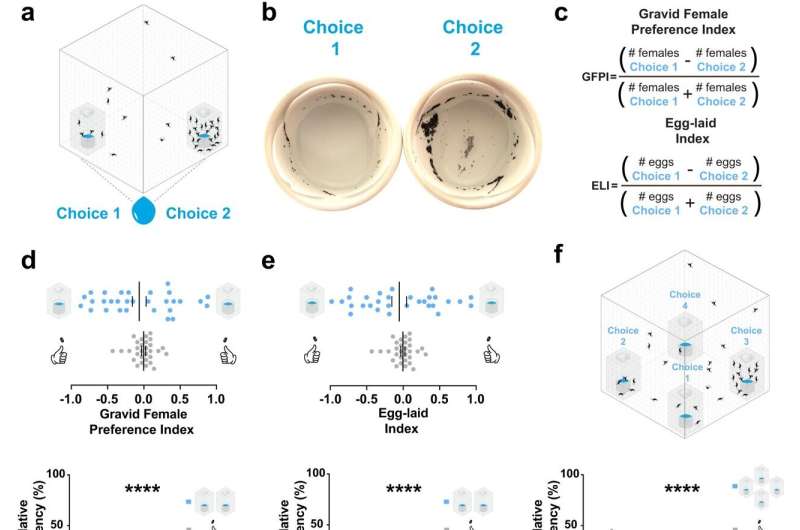This article has been reviewed according to Science X's editorial process and policies. Editors have highlighted the following attributes while ensuring the content's credibility:
fact-checked
peer-reviewed publication
trusted source
proofread
Female mosquitoes found to regulate their own population density at breeding sites using communal cues

When female mosquitoes feed, they don't seem to mind a crowd because lots of carbon dioxide usually means there's food. They were thought to be more solitary, however, when laying eggs. New research has revealed quite the opposite for the deadly Aedes aegypti.
While they do avoid large crowds, the female mosquitoes appear to follow other females and congregate in smaller groups when laying eggs. This new finding, published in Communications Biology, has scientists rethinking the possibilities for mosquito control.
"What we've found is mosquitoes are working together to control their density," said FIU biologist Matthew DeGennaro, co-author of the study and director of the FIU Biomolecular Sciences Institute. "If there's too many, there could be a resource issue. But having some clustering likely provides benefits for the survival of their young."
The researchers say female mosquitoes use a balance of smells to decide where to lay eggs. Some smells attract them to lay eggs, while others make them want to avoid laying eggs. Through a series of lab tests, DeGennaro and his team observed female Aedes aegypti mosquitoes avoiding areas with high amounts of carbon dioxide, likely because lots of CO2 means a large crowd. When the egg-laying females detected smaller clusters of females with eggs or young mosquitoes, again relying on their sense of smell, they moved in.
"It's like female mosquitoes are going to an exclusive pool party," said FIU biologist Andre Luis Costa-da-Silva, lead author of the study. "They don't want too many or too few guests."
Aedes aegypti mosquitoes love urban habitats and can lay in tiny containers that litter our neighborhoods. This makes finding breeding sites difficult. This new understanding of how mosquitoes decide where to lay eggs could also lead to entirely new ways of controlling mosquito populations to reduce the spread of diseases they carry.
"We've discovered a new behavior. Now we are exploring how we can use this to control the choices mosquitoes' make," DeGennaro said. "We don't want mosquitoes throwing their baby showers just anywhere."
More information: Andre Luis Costa-da-Silva et al, Female Aedes aegypti mosquitoes use communal cues to manage population density at breeding sites, Communications Biology (2024). DOI: 10.1038/s42003-024-05830-5
Journal information: Communications Biology
Provided by Florida International University



















